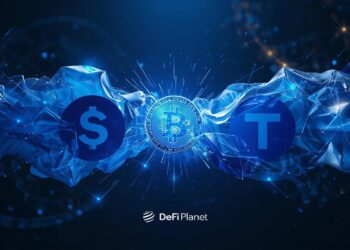Last updated on November 17th, 2022 at 01:23 pm
Decentralized borrowing and lending are important aspects of decentralized finance (DeFi). In DeFi borrowing and lending, Users can borrow crypto loans and then pay back the interest and principal after the specified period.
Crypto lending is a service that connects cryptocurrency lenders and borrowers. Crypto enthusiasts with idle funds in their wallets who are not trading or staking may decide to offer them as liquidity to a crypto lending platform. In exchange, the crypto lending platform pays them interest on funds lent to borrowers.
Decentralized lending platforms can take the form of overcollateralized platforms or flash loan lending protocols.
In overcollateralized lending platforms, borrowers are expected to always ensure their collateral amount is above a particular threshold to avoid liquidation.
There is no collateral in the case of flash loans. Payment on the same transaction is guaranteed with flash loans. If a user is unable to repay in the same transaction, their loan transaction is reversed.
DeFi users can take advantage of overcollateralized lending features provided by the Liquity Protocol.
This article examines the Liquity Protocol and its unique array of functionalities.
What is Liquity Protocol?
Liquity is a decentralized borrowing protocol that allows users to obtain 0% interest loans by using ETH as collateral. It is distinct from other decentralized lending platforms in that it charges a one-time fee to borrow LUSD. Typically, the fee is minimal but variable.
The platform does not charge the typical interest rate that decentralized lending protocols charge. As an overcollateralized lending platform, Liquity Protocol expects its users to have a collateral ratio of at least 110% to avoid liquidation.
To ensure that the DeFi protocol works effectively, it secures loans with the Stability Pool that has LUSD, which is the stablecoin issued by Liquity Protocol. It also has a team of borrowers that act as guarantors, a system used only as a last resort.
Once a user draws LUSD from their Trove on Liquity Protocol, they are expected to pay a one-time borrowing fee, depending on how much is drawn. Liquity Protocol defines the Trove as “where you take out and maintain your loan.”
This fee is then added to the amount borrowed as debt. The system determines the borrowing fee based on a variety of factors. The minimum borrowing fee in the Liquity Protocol is 0.5% in normal circumstances and 0% in recovery mode.
Another fee that borrowers are expected to pay while taking out a loan with this protocol is the Liquidation Reserve charge, which is 200 LUSD. It is returned once the user repays their debt.
If the user is liquidated, they forfeit their Liquidation Reserve charge of $200 USD as well as their collateral. They are not required to repay their loan because the collateral in their Trove is used to cover this. To avoid liquidation, it is important to keep the collateral amount above 110% at all times.
When the minimum collateral ratio of a Trove falls below the 110% threshold, anyone can decide to liquidate it. To encourage users to liquidate Troves that are below the threshold, the Initiator is rewarded with a gas compensation of 200 LUSD + 0.5% of Trove’s collateral.
By agreeing to be the Initiator, the user is expected to pay the gas fees associated with the liquidation process. The Liquidy Protocol has designed a system that ensures that liquidation remains profitable to initiators even when gas fees are high. Usually, the gas compensation covers the liquidation gas fee while offering a profit to the Initiator.
What is the Stability Pool?
A stability pool is one of the safety mechanisms designed to ensure that the ecosystem remains solvent. Typically, it is a liquidity pool that is used to repay the debts that users do not incur. The user’s Trove is liquidated if the minimum collateral requirement falls below the 110% threshold.
To ensure that the system works effectively when a user’s Trove is liquidated, “an amount of LUSD corresponding to the remaining debt of the Trove is burned from the Stability Pool’s balance to repay its debt.”
When this occurs, the system instantly transfers the collateral to the stability pool.
Anyone can inject their LUSD into the stability pool, which is also a liquidity pool. In this context, liquidity providers are referred to as stability providers. Stability providers (SPs) are compensated with a portion of the liquidated collateral.
The collateral in Liquity Protocol is typically Ether, which means that SPs are rewarded with a portion of the collateral associated with a liquidated Trove. In exchange, they forfeit a portion of the LUSD they injected into the pool.
Before a user can borrow LUSD on this decentralized lending platform, they must first deposit Ether as collateral into their Trove. The minimum collateral ratio is at least 110% of the loan amount. This means that at liquidation, the probability of receiving a “greater dollar-value of collateral relative to the debt they pay off” is high.
This may not always be the case, as sometimes, liquidation may occur when the collateral ratio is below 100%, which may translate to a loss for the stability provider.
Aside from liquidation gains, stability providers can benefit from early adopter rewards in the form of LQTY tokens.
The Liquity Protocol’s native token, LQTY, is offered as a reward to those who provide liquidity in the stability pools early.
As a stability provider, the user can withdraw the liquidity they injected into the stability pool whenever they want, as there is no minimum lockup period. This is not always the case, as “withdrawals are temporarily suspended whenever there are liquidatable Troves with a collateral ratio below 110% that have not been liquidated yet.”
Is There A Repayment Schedule On Liquity Protocol?
The architecture of the Liquity Protocol differs from that of other DeFi protocols in that it does not have a repayment schedule for its users. Individuals can take out loans and hold them for as long as they want, as long as their collateral ratio is above 110%. The Liquidy Protocol defines its collateral ratio as “the ratio between the dollar value of the collateral in your Trove and its debt in LUSD.”
As always, it is important to note that the crypto market is volatile, meaning that the risk of liquidation is high because the value of crypto can swing wildly.
What Happens During Liquidation on the Liquity Protocol?
As previously stated, the minimum collateral ratio on Liquity Protocol is 110%, implying that a user’s collateral ratio should be at least the minimum threshold.
Failure to do so could result in liquidation. When a decentralized lending platform liquidates, the user usually loses their collateral. The collateral is sold to repay the user’s debt.
When Does Liquidation Become Unprofitable To Stability Providers?
When Troves are liquidated in Liquity Protocol, stability providers tend to benefit. This is due to the fact that they have access to the collateral associated with the liquidated Trove, which is worth 110 % of the loan amount and is denominated in Ether.
They have the option of withdrawing the Ether and using it as they see fit. In theory, the stability provider has a high chance of benefiting, but this is not always the case. The following are examples of situations in which the SP may lose when a Trove liquidation occurs.
Firstly, the stability provider may lose if the collateral ratio falls below 100%. This is because 100% of the loan amount denominated in LUSD is paid from the Stability Pool, while their supposed reward of Ether, the collateral, is below 100%.
Secondly, the stability provider may face a loss if LUSD is trading above its pegged value of $1. If a liquidation occurs, the stability providers are expected to pay a value of LUSD above their usual payment while receiving their usual reward.
According to Liquity Protocol, “this loss is hypothetical since LUSD is expected to return to the peg, so the “loss” only materializes if you had withdrawn your deposit and sold the LUSD at a price above $1.”
In Conclusion,
- Liquity is a decentralized borrowing protocol that allows users to obtain zero percent interest loans using ETH as collateral.
- Borrowers are required to pay a one-time minute fee as well as a Liquidation Reserve charge, which is refunded when the loan is repaid.
- Liquity Protocol is an overcollateralized lending platform with a minimum collateral ratio of 110%. If it falls below this threshold, the Trove is liquidated.
Disclaimer: This article is intended solely for informational purposes and should not be considered trading or investment advice. Nothing herein should be construed as financial, legal, or tax advice. Trading or investing in cryptocurrencies carries a considerable risk of financial loss. Always conduct due diligence.
If you would like to read more articles like this, visit DeFi Planet and follow us on Twitter, LinkedIn, Facebook, and Instagram.
“Take control of your crypto portfolio with MARKETS PRO, DeFi Planet’s suite of analytics tools.”





















